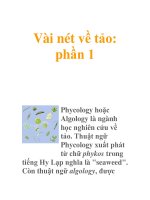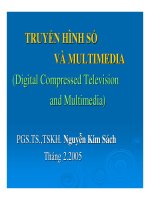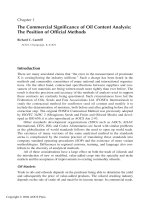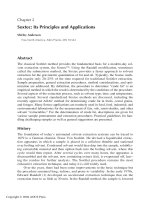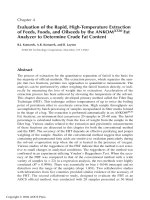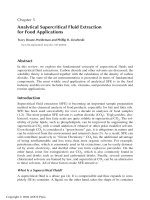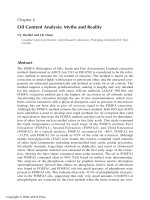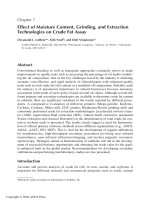oil extraction and analysis phần 1 ppsx
Bạn đang xem bản rút gọn của tài liệu. Xem và tải ngay bản đầy đủ của tài liệu tại đây (290.69 KB, 10 trang )
Chapter 1
The Commercial Significance of Oil Content Analysis:
The Position of Official Methods
Richard C. Cantrill
AOCS, Champaign, IL 61821
Introduction
There are many anecdotal claims that “the error in the measurement of proximate
X is costing/losing the industry millions.” Such a charge has been heard in the
methods and commodity committees of many national and international organiza-
tions. On the other hand, contractual specifications between suppliers and con-
sumers of raw materials are being written much more tightly than ever before. The
result is that the precision and accuracy of the methods of analysis used to support
these contracts are routinely being questioned. Such circumstances have led the
Federation of Oils, Seeds and Fats Associations Ltd. (FOSFA International) to
study the contractual method for sunflower seed oil content and modify it to
include the determination of moisture, both before and after grinding before the oil
extraction step. The original FOSFA Contractual Method was previously adopted
by ISO/TC 34/SC 2 (Oleaginous Seeds and Fruits and Oilseed Meals) and devel-
oped as ISO 659; it is also reproduced as AOCS Am 2-93.
Other standards development organizations (SDO) such as AOCS, AOAC
International, CEN, ISO, and Codex Alimentarius are faced with similar problems
as the globalization of world standards follows the need to open up world trade.
The existence of many versions of the same analytical method in the standards
arena is complicated by the routine practice of translating these standards into
company standard operating procedures (SOP) and the existence of more variant
methodologies. Differences in regional customs, training, and language also con-
tribute to the diversity of analytical methods.
All of these considerations have a large effect on both the trade of oilseeds and
the introduction of new or modified, value-added crops into the specialty and niche
markets and the acceptance of improvements to existing commodity oilseeds.
Oil Markets
Trade in oils and oilseeds depends on the purchaser being able to determine the yield
and subsequently the price of value-added products. The oilseed crushing industry
depends on the sale of crude oil and meal for its income stream. In commercial trade,
Copyright © 2004 AOCS Press
commodity prices are set by the major grain exchanges (e.g., Chicago Board of
Trade) and by contractual agreement. Discounts and premiums may be paid on
contract specifications depending on whether the purchased lot fails to meet,
meets, or exceeds these specifications. The acceptability of the lot depends on the
analytical results of samples collected according to specific sampling protocols, the
price paid, and the anticipated yield of products.
Soybeans have a nominal composition of 38% protein, 15% soluble carbohy-
drate, 18% oil, 14% moisture and ash, and 15% insoluble carbohydrates (dietary
fiber). Soybean crushers (processors) buy beans on the expectation of making a
profit from the production and sale of soybean meal and oil.
The soy crush margin can be calculated as follows: Margin = [(price of soybean
meal × pounds of meal per bushel) + (price of soybean oil × pounds of oil per bushel)]
– price of soybeans per bushel (1). According to USDA statistics, the margin has
rarely been above $1/bushel and has generally been ~$0.75 over the last 15 y (2).
Crush margins assume that 1 bushel of soybean (60 lb) yields 48 lb of meal with 44%
protein and 11 lb of oil. Because soybean quality varies among varieties and from
region to region, the actual yield of oil and meal differs from the assumption above.
A calculator to determine the Expected Processing Value (EPV) may be found
at www.stratsoy.uiuc.edu. This tool, based on a publication by Brumm and
Hurburgh (3), determines the value of soybeans on the bases of their protein and
oil content. It uses these values together with commodity prices quoted on the
Chicago Board of Trade for soybean meal and oil to determine the processed
value. Although there are some assumptions made in the calculation, valuable
potential revenue information can be determined (Table 1.1). Profitability is further
related to operational efficiency, transportation logistics, and capacity utilization.
All of these factors play an important role in the final margin realization.
Any number of potential scenarios can be run using EPV to determine the
magnitude of the effect of protein and oil content on profitability. At present, the
value of the soybean is limited by the values of protein and oil content. Limits are
set by the available commodity seed stocks. However, because greater profitability
exists in sourcing higher-quality raw materials, soybean buyers are aware of this
opportunity and search out these stocks.
TABLE 1.1
Example of Output from an Expected Processing Value (EPV) Calculator
Calculation inputs $/bu
Soybeans 4.40
Calculation results $/bu
Meal 3.74
Oil 1.44
Hulls 0.14
Subtotal 5.32
Theoretical margin 0.92
Copyright © 2004 AOCS Press
Quality parameters also affect the international trade in oilseeds. The recent
acknowledgment of genetically modified soybeans in Brazil removes some of the
competitive advantage of soybeans from that area. However, increased yields and
increased production in South America are driving U.S. producers to look at the
quality of U.S. soybeans to determine a competitive advantage. Production and
consumption of oilseeds generally go hand in hand. Reviews of the production of
oilseed and oils and fats are regularly produced by world experts Frank Gunstone
and Thomas Mielke and may be found in the AOCS membership publication inform
(4–6).
Development of a Quality Assurance Program
Evidence is available from the USDA, the United Soybean Board (USB), and other
sources detailing the effect of location within the United States on soybean quality.
Each industry would, within the limitations of economic feasibility, source oilseeds
with the highest quality. In a commodity-based industry in which the farmer is paid
on yield, and profits are determined after the fact, sourcing suitable oilseeds for
crushing is more of an art than a science. However, the oilseed trade could be revo-
lutionized if oilseeds with higher levels of protein and oil or other desirable con-
stituents were available on the U.S. market on a regular universal basis. This latter
goal is the driving force for the USB Better Bean Initiative. For further details of
this program visit www.unitedsoy.org. The program promotes the development of
soybeans with enhanced quality traits such as increased oil and protein content,
enhanced amino and fatty acid composition, and low phytate content while main-
taining yield. Because differences in the precision and accuracy of methods of
analysis will hinder the introduction and identification of new varieties of com-
modity oilseeds, this program has also recognized the need for analytical perfor-
mance. In 2002, USB sponsored a 4-y program with AOCS to introduce the
Soybean Quality Traits Analytical Standards Program (SQT) (Table 1.2).
With the initiation of a proficiency testing program to support SQT, AOCS is
currently (end of 2003) proceeding with phases 3 and 4. In parallel, the develop-
ment of a program to support the use of near infrared (NIR) spectroscopy for the
analysis of soybean quality traits is underway. In an ambitious and highly coopera-
tive program, the seed breeders, NIR equipment manufacturers, analytical labora-
tories, consultants, and academics have come together to foster the development of
a library of diverse soybean samples to support NIR calibrations for protein, oil,
and fatty acid composition. In future developments, it is anticipated that phytate,
amino acid composition, and other analytes will be included.
Factors Determining the Use of Globally Recognized Standards
When considering how complex the soybean industry appears, how integrated the
activities and the wealth of expertise available, it is easy to question the need for an
analytical system to ensure confidence in the identification of crops with enhanced
Copyright © 2004 AOCS Press
traits. In fact it is the complexity of the current model that drives the need for stan-
dardization. Both internal and international trade in oilseeds require the assurance
of analytical values.
When contracts specify the expected level of an analyte, they may also specify
the method of analysis. This recognizes the variability among different methods of
analysis and their performance characteristics, and many disputes are averted
because of this understanding. However, these differences in the methods of analy-
sis are inherent from their empirical nature. AOCS has methods for the determina-
tion of oilseed fat content dating from the 1930s. At the time of their introduction,
they were considered state of the art and an industry standard. Still in use today,
they remain the methods of choice in arbitration, and closely related versions of the
same methods can be found in the collections of many SDOs.
Fats, Oils, and Lipids Methods Standardization
There is a long list of developers of national and international standards. Although
national standards bodies generally adopt standards methods that have been devel-
oped through international cooperation, they may also be developed internally in
response to the needs of the trade or other organizations. These standard methods
often form the basis of future international methods. In the United States, national
standards are published by ANSI, although the developmental work may be carried
out by any of a large number of professional organizations. However, in this arena,
TABLE 1.2
Features of the AOCS-USB SQT Program
Phase 1 Identify analytical methods for
Protein content
Oil content
Fatty acid composition analysis
Phase 2 Develop and validate methods of analysis including the evaluation of secondary
methods
Phase 3 Identify users and their requirements
Seed companies
Referee and private laboratories
End-user laboratories
Elevator and crop handling facilities
Establish a core group of expert laboratories
Phase 4 Develop Soybean Quality Traits Laboratory Program, including use of proficiency
testing and standards
Phase 5 Implement laboratory quality assurance
Standard methods
Certification
Proficiency participation
Results monitoring
Phase 6 Encourage incorporation of SQT methods of analysis into ISO 17025 certification
and quality audits
Copyright © 2004 AOCS Press
AOCS is recognized as an international nongovernmental organization (NGO)
with wide global representation.
Most standards organizations publish their own standards and rely on volunteer
committees to carry out the developmental and technical work. This generally requires
the provision of precision data that are based on collaborative studies as defined in
either ISO 5725:1994 (7) or the IUPAC/AOAC Harmonized Protocol (8). Both stan-
dards allow the user to calculate the number of laboratories and samples required to
provide a good estimate of precision. In most cases, results from 8–15 laboratories for
3–5 samples covering the level of expected values are required for each analyte and
matrix covered by the method. The IUPAC/AOAC protocol requires the participation
of 5 international laboratories, whereas ISO stipulates that 5 countries agree to partici-
pate in the development of the method. There are also minor differences in the statisti-
cal treatment of the data to determine outliers, although this does not generally affect
the outcome of the analysis of the collaborative study.
ISO (International Organization for Standardization; www.iso.org) standards for
the fats and oils community are developed by Subcommittees 11: Animal and
Vegetable Fats and Oils (TC 34/SC 11) and 2: Oleaginous Seeds and Fruits and
Oilseed Meals (TC 34/SC 2) of ISO Technical Committee 34 Food Products (ISO/TC
34). ISO uses a 6-step consultative process to ensure consensus and participation of
interested parties. One of the characteristics of ISO standards is that the standard itself
may contain only references to other appropriate ISO standards. In recent years, how-
ever, ISO has recognized that the source scientific literature is relevant to ISO stan-
dards and may be included in Appendices to methods.
CEN (European Committee for Standardization; www.cen.be) publishes stan-
dards that meet the specific needs of European countries in response to the needs of
European industry and the regulations of the European Commission. Fats and oils are
handled by TC 307 “Oilseeds, vegetable and animal fats and oils and their by-prod-
ucts—Methods of sampling and analysis.” Under the Vienna Agreement, ISO and
CEN agree to cooperate in the development of standards without duplication. Work
started by CEN may be transferred to ISO, and CEN adopts ISO standards wherever
possible. Methods are developed by a process similar to the ISO process.
The International Union for Pure and Applied Chemistry, IUPAC (www.iupac.
org) has had a long history of developing methods of analysis for fats and oils. Many
of these have formed the basis for harmonization efforts in the fats and oils arena and
have been adopted and refined by sister organizations. Although the members were a
very active group of dedicated scientists, the Fats and Oils Commission was incorpo-
rated first into the Food Chemistry Division, and the latter group was absorbed into the
Division for Chemistry and the Environment as IUPAC moves onto a grant-based/pro-
ject-based program.
AOCS (www.aocs.org) supports and maintains an active standards development
program and publishes methods for the fats and oils industry in the Official Methods
and Recommended Practices of the AOCS. This compendium contains >400 meth-
ods of analysis for oilseeds, oils, fats, and their derivatives. Additions and Revisions
Copyright © 2004 AOCS Press
are published annually and the whole volume reviewed on a 5-y cycle. In line with
the expectations of ISO 5725 and the IUPAC/AOAC harmonized protocol, new
methods are studied collaboratively before publication as Official Methods.
Recommended Practices are those methods either with a limited scope, incomplete
validation, or urgently needed by the fats and oils industry. The methods program
is supported by an Editor-in-Chief, currently David Firestone, the Uniform
Methods Committee (UMC), and a number of technical subcommittees of experts
in particular methods of analysis or matrices.
AOAC International (www.aoac.org) has a long history of providing methods of
analysis. Its method validation programs comprise the AOAC
®
Official Methods
SM
Program
®
, a Peer-Verified Methods
SM
Program
®
, and the AOAC
®
Performance
Tested Methods
SM
Program. In addition, AOAC International is in the process of
developing an online methods resource (eCAM) that will be a compilation of analyti-
cal methods from many organizations. A method published under the AOAC
®
Official
Methods
SM
Program
®
requires collaborative study data from a minimum of 8 inde-
pendent laboratories. Peer-Verified Methods
SM
provide a rapid way for methods to be
recognized by a standards writing body at an entry level of validation.
National Professional Associations
IUPAC, AOCS, and AOAC International are some of the international professional
associations with standard methods development programs; however, there are also
many national associations that publish standard methods either in the national lan-
guage or because they meet specific regional needs.
Trade Associations
Industrial trade associations may require special methods to be used by their mem-
bers to support the exchange of goods. Although many methods have been pro-
posed for adoption as national or international standards, for others, there is an
insufficient amount of precision data available or a more generic method is already
available on a national or international basis. Some trade methods have been
retained to ensure the continuity of trade because a newer international standard
may give slightly different results.
In the area of fats and oils, several trade associations play a role in developing
analytical methods for their members. FOSFA International (www.fosfa.org), a world
leader in the area of fats, oils, and oilseeds, maintains a technical manual that lists
methods that are to be used as part of trading contracts among its members. The man-
ual lists methods developed by international groups such as ISO, IUPAC, and AOCS,
and maintains FOSFA methods when no official methods are available.
Process for AOCS Approval of Official Methods
Methods submitted for inclusion are first screened by the Technical Department of
AOCS and then evaluated by one of the subcommittees. The response of the sub-
Copyright © 2004 AOCS Press
committee is relayed to the author or proposer, and the revised proposal is considered
by the subcommittee. If more validation data are required, the method may be consid-
ered as a Recommended Practice and forwarded to the UMC or a collaborative study
will be proposed. The Technical Department is available to conduct the trial or ana-
lyze the data. Once the method is approved by the subcommittee, it is passed to the
UMC for consideration and voting. With the use of electronic manuscript transmis-
sion, the whole process can be achieved within 6 mo to 1 y and a new method can be
incorporated into the next set of annual Additions and Revisions. In 2001, in response
to consumer requests and the trend toward the purchase of individual methods brought
about by the requirements of ISO 17025, AOCS introduced Methods Online, which
allows users to search the AOCS Methods of Analysis and select individual methods
on the AOCS website and receive them in electronic format. AOCS harmonizes and
maintains it methods through active participation in ISO, CEN, Codex Alimentarius,
IUPAC, AOAC, AACC, and IOOC.
Process for the Maintenance of Standard Methods
Most standards writing organizations have instituted a process for review of meth-
ods with the aim of confirming, revising or deleting them. These reviews usually
take place on a regular schedule of 3–5 y. All ISO standards must be reviewed
once every 5 y. At this time, the voting committee members are asked to decide
whether a standard should be confirmed, revised, or withdrawn on the bases of its
relevance, usage, and technical merit.
Interactions Between Standards Developing Organizations
The last 15 y have seen a major increase in the harmonization of methodologies
among SDOs. IUPAC, ISO, AOAC International, and AOCS have actively pursued a
program of harmonization of methodologies. The provision of lists of methods of
analysis in many Codex Alimentarius documents has done much to foster this process.
Codex Alimentarius, a governmental organization set up under the auspices of FAO
(Food and Agriculture Organization of the United Nations) and the WHO (World
Health Organization) sets guidelines for food safety and trade in food. The activities
of the Codex Committee on Fats and Oils (CCFO) and the Codex Committee on
Measurement, Analysis and Sampling (CCMAS) are of particular importance to the
harmonization activities of AOCS and its partners. As a recognized international
NGO, AOCS participates actively in these activities and provides comments in areas
in which agenda items affect the interests of the AOCS membership. AOCS methods
of analysis can be found listed in relevant Codex documents.
The Interagency Meeting (IAM), a subcommittee of CCMAS, currently com-
prises more than 30 NGOs listed in the CCMAS Directory of Organizations,
“known to be active in the field of methods of analysis and sampling” or that have
had a method adopted by the Codex Commission. Harmonization is also accom-
plished by the inclusion of a significant number of representatives from many dif-
Copyright © 2004 AOCS Press
ferent organizations on several of the major committees. An impetus for harmo-
nization is the desire to avoid holding more than one expensive collaborative trial
for new methodologies (9).
AOCS continues to focus on the needs of the fats and oils community and is
seen as an advocate for fats and oils methods. Although there is much to be gained
from the harmonization of methods of analysis, there remains a regional preference
for methods of analysis from different organizations. It is not clear whether this is
based on language, style, the experience and training of laboratory staff and asses-
sors, or habit. These questions are frequently addressed by those concerned with
the market share of the methods of a particular organization.
Issues Related to Differences in Analysis Procedures
The list of reasons for the establishment of several different methods for the determi-
nation of the same analyte can be very long. Historically, different techniques grew up
around a specific matrix (oilseed) and location. The development of general methods
has been one of trial and error. Even among the AOCS methods, where many simple
methods are repeated for single oilseeds, it has proved to be a difficult task to develop
generic methods and then compile the special considerations for each application.
Sampling and laboratory sample preparation are central to the performance of any
method and are important considerations when determining the precision of an analyti-
cal technique. In the development of oilseed extraction technology, the choice of sol-
vents and the type of equipment play an important role. Many methods committees
have devoted considerable time to the discussion of the philosophical question “what
is oil?” Because the degree of lipid extraction is highly solvent dependent, answering
this question is at the center of determining the equivalence of different methods
whether they are standard methods or equipment-based or semiautomated systems.
Up to now, standardization procedures have been developed to consider only
generic public-domain methods in a recipe-like prescriptive manner. Comparison
with proprietary methods has not been performed on a large scale. This book
describes one attempt to conduct such a study using the same samples in parallel
(see Chapter 3 of this book, Accelerated Solvent Extraction). It takes considerable
time, money and goodwill to carry out successful comparisons. Without the help of
major corporations and equipment vendors, it is not possible to reach statistically
sound conclusions. AOAC has addressed this need through its Research Institute
and Peer-Verified Methods program, whereas AOCS has established AOCS
Approved Procedures as a category of official methods.
Need for Harmonization of Procedures
In the face of such a large number of different methods and technologies to deter-
mine the oil content of oilseeds, why should there be methods harmonization? The
answer is clearly financial. If a seed company develops an oilseed with enhanced
quality traits, then to make a return on its investment, it must have market penetra-
Copyright © 2004 AOCS Press
tion and be able to assure the buyer that these traits exist and represent a benefit to
the value chain. Without supporting analytical data, these claims cannot be sub-
stantiated. The use of different methodologies to determine the trait can easily lead
to loss of confidence. Hence, there is a need for consistent methodology. In the
case of a dispute between the buyer and seller, the dispute may be settled by arbi-
tration; in that case, a referee laboratory will be selected to perform the analysis
according to an agreed reference methodology.
In recent meetings, the Codex Committee on Measuring, Analysis and Sampling
has proposed the use of performance-based criteria in the establishment and use of
methods of analysis. Although this appears to be a challenge to the adoption and use of
official methods and international standards, the list of required performance criteria is
long and onerous. The degree of validation required may convince the laboratory to
adopt and use official methods. The determination of performance criteria or the publi-
cation of precision data from a collaborative study in an official method allows the
user to determine whether the method will fulfill his needs and whether it is fit-for-pur-
pose. Indeed, the development and interpretation of performance criteria may be con-
sidered another way of looking at fitness-for-purpose.
Challenges for Harmonization
For an SDO and its volunteer members, there is no difficulty in deciding whether
the standard developed by another organization is similar enough to its own to con-
sider harmonizing with it. The challenge is to convince current method users that
there is an improvement in performance if certain changes are made. When indus-
tries are consolidating and looking for ways to streamline and economize, they are
less likely to accept the advice of standards organizations. They are more likely to
implement vertical integration within the different business units, thereby making
official methods secondary to in-house methodology.
This may be seen as a problem for the SDO in the short term, but the stream-
lining of company activities is also a fertile area for invention through miniaturiza-
tion, high-throughput, real-time, and novel in-line technologies. In the future, these
technologies will require recognition and validation through collaborative trial, a
role that many SDOs have been performing for the last century.
Acknowledgments
This chapter was based on a presentation made at the AOCS Annual Meeting 2003 in
Kansas City, MO, entitled: The Commercial Significance of Oil Content Analysis, Richard
Cantrill. Thanks are given to John Hancock, FOSFA International, London, UK and Mark
Matlock, ADM, Decatur, IL for their discussions and loan of materials.
References
1. University of Illinois, Stratsoy, Grain Market Analysis, />faq.pdl?project_id=9&faq_id=677 (November 2003).
Copyright © 2004 AOCS Press
2. United States Department of Agriculture, Oil Crops Situation and Outlook Yearbook,
(November
2003).
3. Brumm, T.J., and Hurburgh, C.R., Jr. (1990) Estimating the Processed Value of
Soybeans, J. Am. Oil Chem. Soc. 67: 302–307.
4. Gunstone, F. (2003) Early Forecasts for World Supplies of Oilseeds and Vegetable Oil
in 2003–2004, inform 14: 668.
5. Mielke, T. (2003) The World Outlook for Major Oilseeds, inform 14: 712–713.
6. Gunstone, F. (2003) Soy—Beans, Oil and Meal, inform 14: 720–721.
7. ISO 5725 (1994) Accuracy (Trueness and Precision) of Measurement Methods and
Results, Parts 1–6, International Organization for Standardization, Geneva.
8. Horwitz, W. (1995) Protocol for the Design, Conduct and Interpretation of Method
Performance Studies, Pure Appl. Chem. 67: 331–343.
9. Daun, J.K., and Cantrill, R.C. (2003) Process for Development of Standard Methods for
the Analysis of Fats, Oils and Lipids, in Advances in Lipid Methodology—Five (Adlof,
R.O., ed.) pp. 273–299, The Oily Press, Bridgwater, UK.
Copyright © 2004 AOCS Press

